Are you considering using blackened steel for your next home project but unsure where to begin?
I understand, it can be difficult to choose the right finish, especially with something as unique as blackened steel.
If you’re using it for practical purposes or for purely decorative ones, selecting the right style and process is key.
Having worked with various materials, I can say that blackened steel provides a sleek, versatile finish that works well in both modern and industrial settings.
In this blog, I’ll guide you through how this finish can be used in different spaces, as well as the processes involved in blackening steel, helping you select the best style and technique for your project.
Practical Uses of Blackened Steel Finish
Blackened steel is a versatile and durable material that works well in both functional and decorative spaces. With the right care, it’s an excellent choice for high-traffic areas and heavy-use items.
1. Kitchen Backsplashes
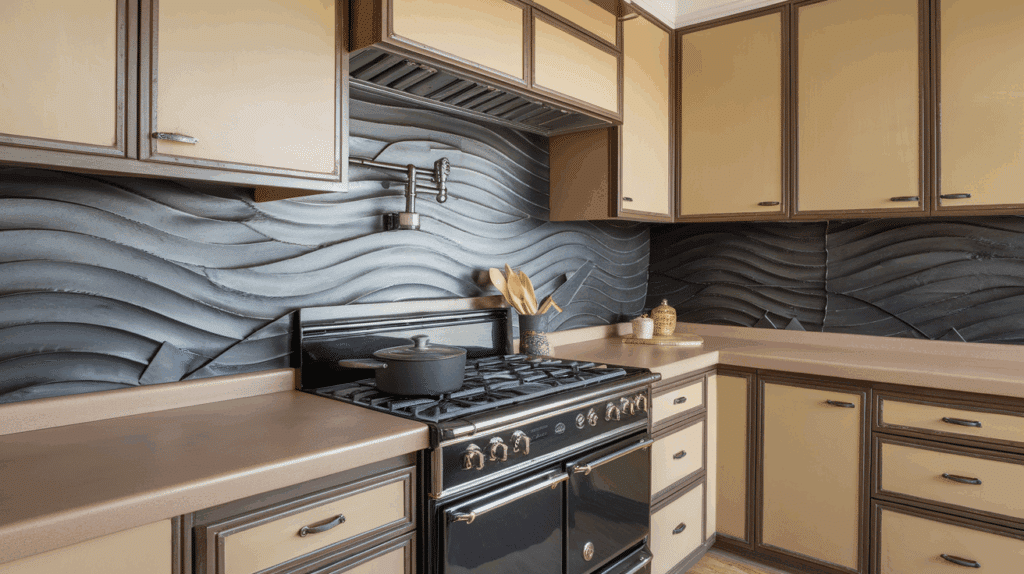
Blackened steel backsplashes provide a sleek, modern feel in kitchens. The deep, matte finish contrasts beautifully against lighter countertops and cabinets.
It’s heat-resistant, making it perfect for areas around the stove, and its non-porous nature helps resist stains from grease and water.
However, it can develop a patina over time, which may appeal to some but can make it look worn.
To maintain its clean appearance, I recommend cleaning it with a damp cloth regularly and using a mild soap if necessary. For added protection, you can apply a clear coat to prevent scratches and rust, ensuring it stays in top shape for years.
2. Cabinet Handles & Hardware
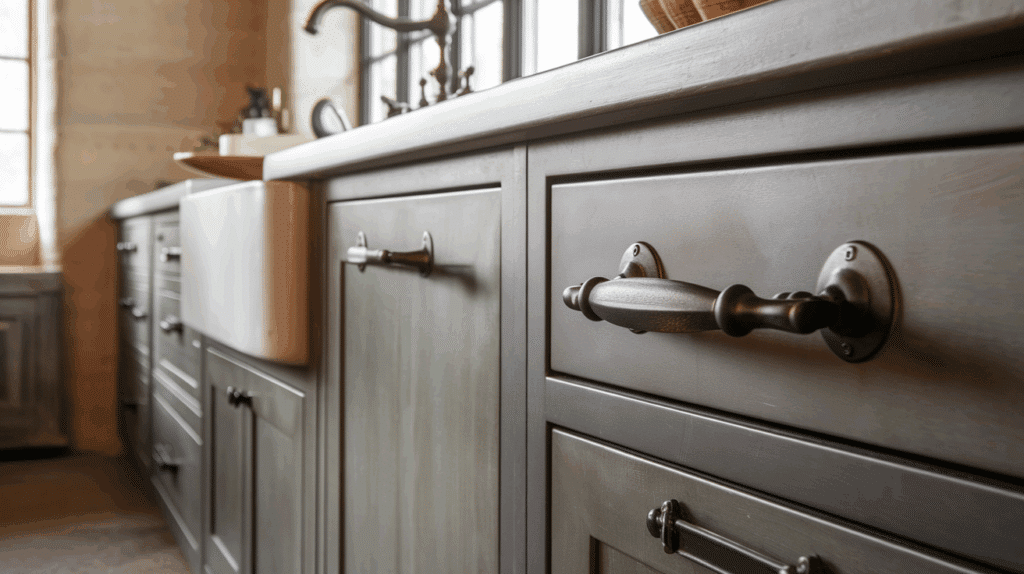
Blackened steel hardware, such as cabinet handles, can add a strong yet understated touch to your kitchen or bathroom. The dark, matte surface works particularly well in industrial, modern, or rustic designs.
It’s resistant to rust and moisture, but like any metal, it can develop small scratches over time, giving it a more weathered look.
Regular dusting and wiping with a soft cloth will keep it looking fresh. If you notice any heavy buildup or fingerprints, use a mild cleaning solution to wipe it down.
While the finish holds up well, I recommend applying a protective wax or clear coat for extra durability.
3. Bathroom Fixtures
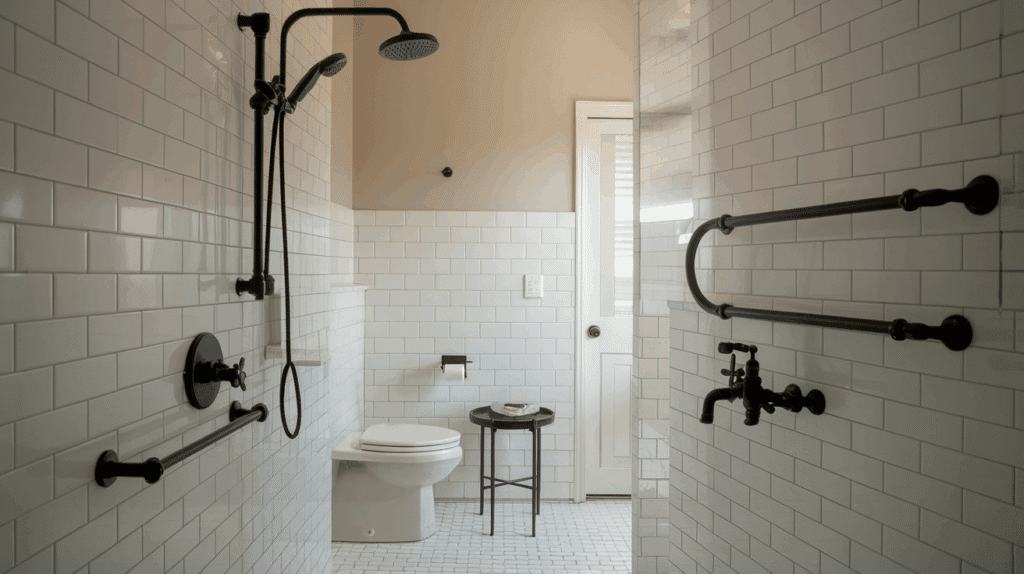
In bathrooms, blackened steel fixtures like faucets, towel bars, and showerheads can create a striking contrast against white tiles or glass. Its modern, industrial look works well with both contemporary and minimalist designs.
The steel is corrosion-resistant, but frequent exposure to water can result in water spots or streaks.
To prevent buildup, dry the fixtures after each use and wipe them down with a soft cloth.
Over time, blackened steel can develop a patina, which adds character but may need maintenance to prevent rusting. Applying a water-resistant sealant can help protect the finish and keep it looking pristine.
4. Shelving Units

Blackened steel shelving units are a practical and stylish storage option for kitchens, living rooms, or home offices. The sturdy, industrial design can hold heavy items, making them perfect for books, plants, or kitchenware.
The finish’s matte, dark color contrasts beautifully with natural wood or glass shelves, offering a modern look without overwhelming the space.
However, blackened steel may show dust, fingerprints, or scratches over time.
To maintain its appeal, I recommend wiping the shelves down with a soft, dry cloth regularly. If you want to keep the finish pristine, consider applying a thin layer of clear wax or a sealant for added protection.
5. Stair Railings

Using blackened steel for stair railings gives a space an industrial yet sophisticated feel. The finish is both strong and visually appealing, adding an edgy look to open staircases in modern homes.
Blackened steel is incredibly durable, handling regular use without much wear, but it can show fingerprints and smudges.
Over time, it may develop a patina, which some homeowners find desirable.
To care for the railings, clean them regularly with a dry cloth to remove dust and fingerprints. If exposed to moisture or high humidity, I recommend sealing the steel to prevent rust and preserve the finish for longer.
6. Fireplace Screens
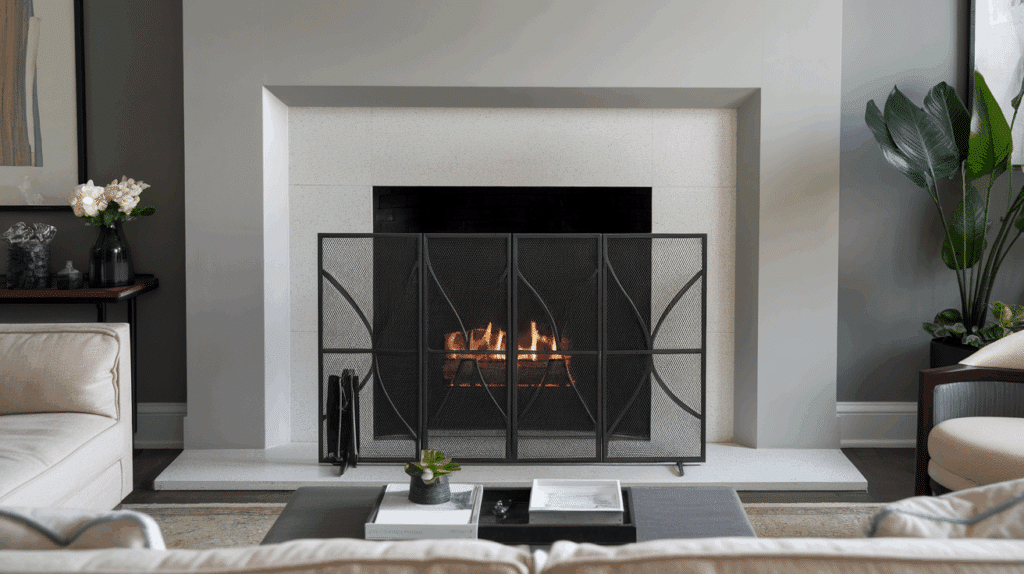
Blackened steel fireplace screens are a great way to add a modern touch to your living room while providing safety for the fireplace.
The finish not only complements the warmth of the fire but also adds durability. It can withstand high heat, which makes it a practical choice for this application.
However, soot and ash can accumulate on the surface, leading to discoloration if left untreated.
After each use, I suggest wiping the screen down with a damp cloth to remove soot and dust. Applying a thin layer of protective wax or sealant can prevent corrosion and keep the blackened steel looking fresh.
7. Windows and Door Frames

Blackened steel window and door frames offer a sleek, modern look that complements both minimalist and industrial interiors. The strong material creates a beautiful contrast with glass panes or wooden surfaces.
Blackened steel is highly durable and can handle wear and tear from daily use. However, the finish may show dust, dirt, and fingerprints.
For regular maintenance, wipe the frames with a soft, dry cloth to remove dust. For more stubborn grime, use a mild cleaning solution.
If your frames are exposed to outdoor elements, consider applying a clear protective coat to help prevent rust and maintain the finish.
Decorative Uses of Blackened Steel Finish
This material is not just about function; it also brings style, edge, and sophistication to any space. Now, let’s see how blackened steel can be used in decorative settings.
8. Accent Wall Panels
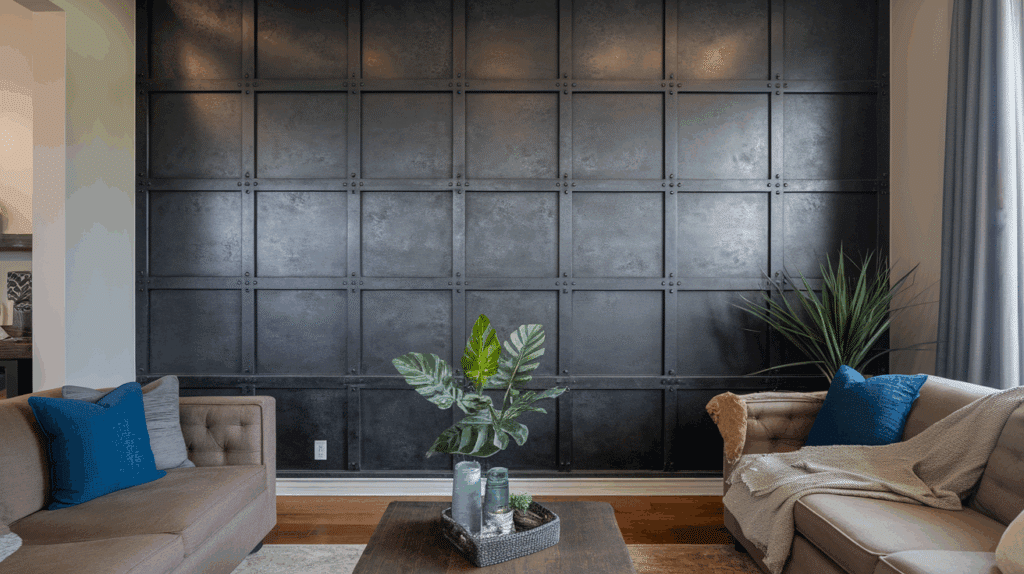
Blackened steel accent wall panels can dramatically change the atmosphere of a room. The material’s deep, matte finish adds texture and interest, making it ideal for creating a bold statement in living rooms or dining spaces.
It pairs well with both light and dark furniture, adding a modern, industrial touch.
One thing to consider is that blackened steel can develop a natural patina over time, which might appeal to some but may not suit all preferences.
To keep it looking clean, I suggest regularly wiping it down with a soft cloth to prevent dust buildup and using a protective coating to minimize scratches.
9. Furniture Legs
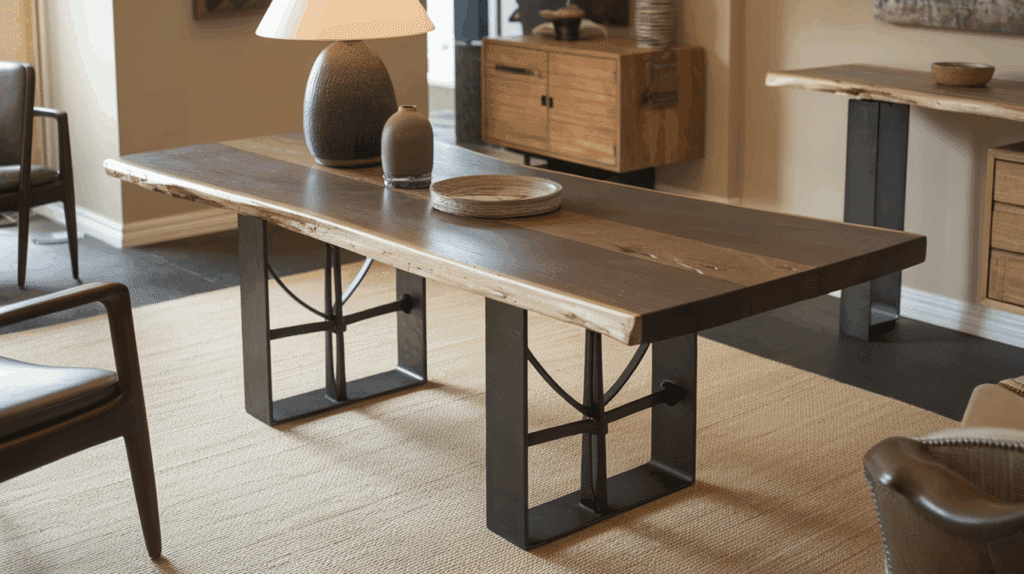
Blackened steel furniture legs, such as those on coffee tables or dining tables, offer a sturdy, industrial edge to any piece.
The sleek finish contrasts nicely with wooden or glass table surfaces. It’s perfect for contemporary or loft-style settings where you want a strong, minimalistic base.
While durable, blackened steel can show wear over time, especially if exposed to rough handling.
To keep it looking sharp, dust the legs regularly and clean them with a soft cloth. Applying a protective sealant will help preserve the finish and prevent corrosion, keeping the legs looking fresh for years.
10. Lighting Fixtures

Lighting fixtures made from blackened steel can serve as functional art pieces. The finish complements both modern and industrial styles, adding a touch of drama without overwhelming a room.
These fixtures are durable, offering a sleek look that won’t fade over time.
The only downside is that dust and grime can accumulate on the surface, dulling its appearance.
I recommend cleaning your blackened steel lighting with a soft, dry cloth regularly. If needed, use a mild cleaner for tougher spots. For added protection, apply a light coating of wax to prevent rust and keep it looking polished.
11. Wall Art
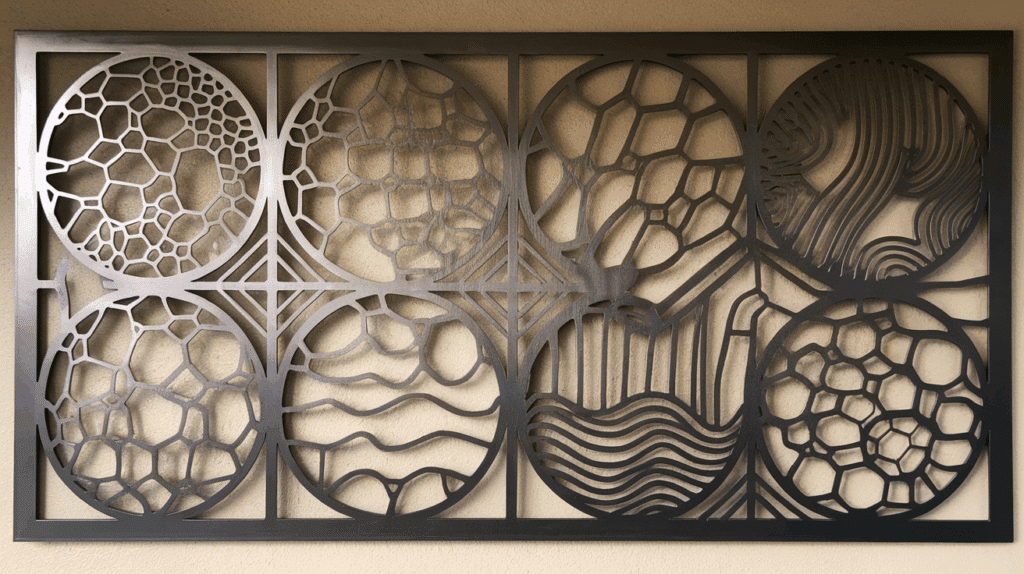
Blackened steel wall art creates a striking visual impact, especially in rooms with lighter-colored walls. The matte finish of the steel contrasts well with vibrant colors and can be used as the focal point of a room.
Since the material is durable, it can last for years with minimal maintenance. However, like other blackened steel pieces, it can develop a patina or rust over time.
To preserve its appearance, I recommend wiping it down with a soft cloth to remove dust.
For extra care, use a sealant to prevent moisture from affecting the steel and keep the artwork looking pristine.
12. Outdoor Signage
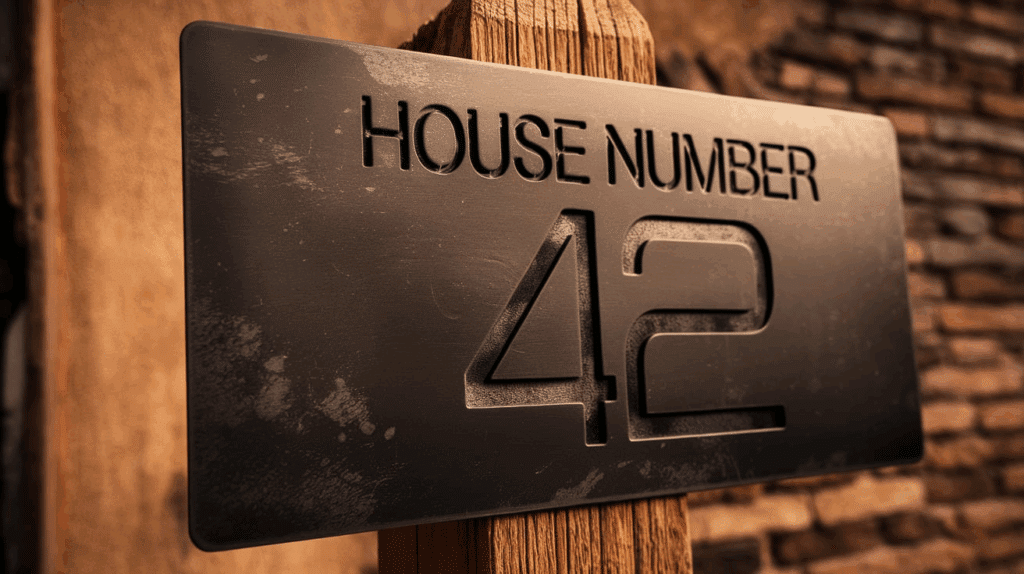
Blackened steel is a great choice for outdoor signage due to its durability and industrial look. Whether you’re displaying house numbers or a business name, blackened steel adds an elegant yet sturdy option.
The material resists the elements, but it can rust if exposed to moisture over time.
To maintain its fresh appearance, wipe the signage down regularly to remove dirt or debris.
If you’re concerned about the steel’s exposure to the weather, apply a rust-resistant coating to protect the finish from the elements and help it last longer.
13. Decorative Trays
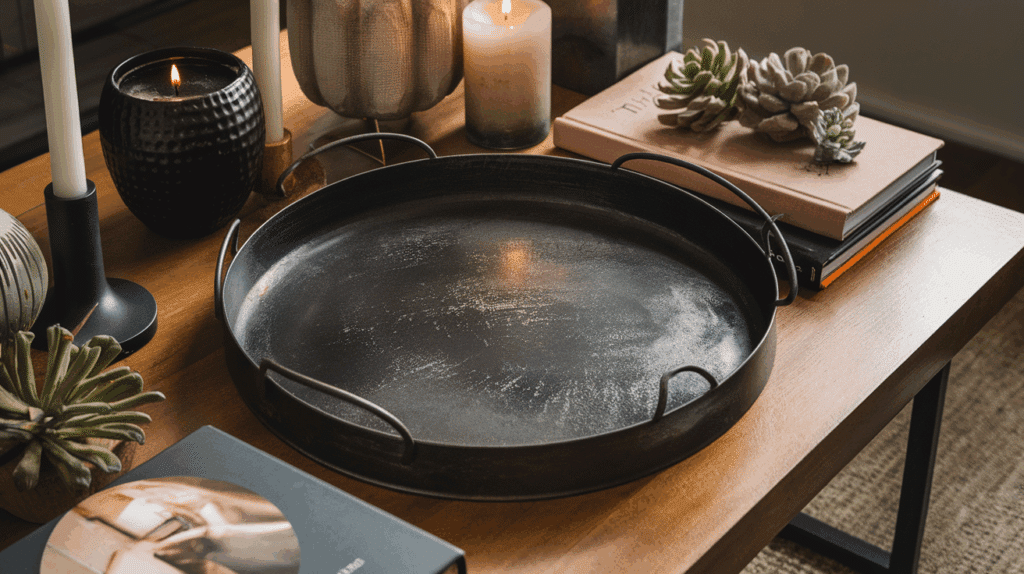
A blackened steel tray can serve both decorative and practical purposes. Whether on a coffee table, kitchen island, or bathroom counter, it’s a sleek, stylish option for holding items or serving drinks.
The deep, matte finish adds an industrial edge, and the material is durable enough to withstand daily use. However, like other blackened steel items, it may show scratches and fingerprints over time.
Regular dusting with a soft cloth will help maintain its look. If you want to protect the surface from wear, consider applying a thin layer of wax to preserve the finish and prevent it from losing its luster.
14. Mirror Frames
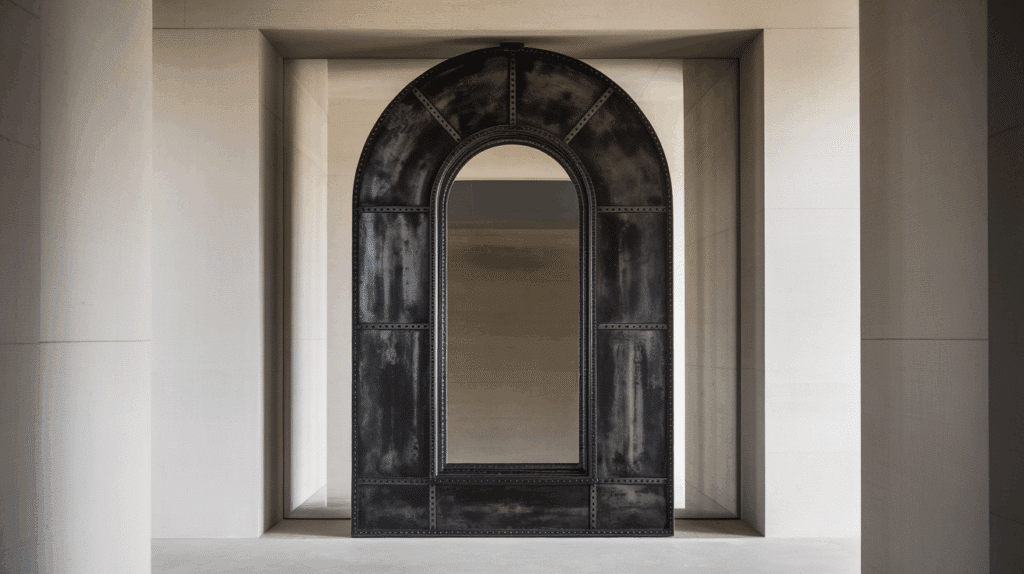
Blackened steel mirror frames add a modern industrial touch to any room.
The finish is dark and matte, giving it a sleek, minimalistic look. It contrasts well with both light and dark walls, making the mirror stand out.
The steel is durable, but over time, it can show fingerprints, dust, and slight scratches. It may also develop a patina, which some people appreciate for its vintage feel, while others may not.
To keep it looking good, I recommend dusting it regularly with a soft cloth. If you want to prevent rust, applying a light layer of protective wax will help preserve the finish.
15. Sculptures
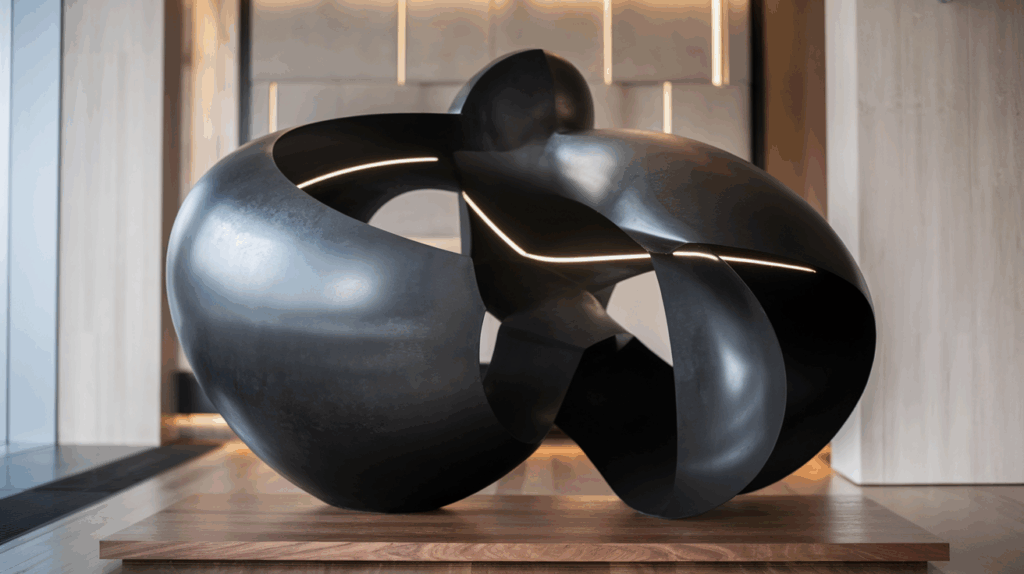
Blackened steel sculptures can make a bold statement in any room, offering a unique, industrial aesthetic.
The matte finish gives the piece a modern, sophisticated look, while the steel’s strength ensures it can hold its shape over time.
However, the finish may develop a patina, which some find desirable, while others may prefer to keep it pristine. Like other blackened steel items, it can show dust and fingerprints.
To maintain its appearance, I recommend dusting the sculpture regularly with a soft cloth. If you want to prevent rust or wear, applying a clear protective coating will help keep the steel looking fresh.
Different Processes of Blackening Steel
Blackening steel is a process that enhances both the appearance and durability of the material.
1. Hot Blackening (Hot Dip Blackening)
Hot blackening, also known as hot dip blackening, is a process where steel is dipped into a hot solution, often a mix of iron and carbon, to create a durable black coating. This is one of the most robust blackening methods.
- Materials: Iron, carbon, hot chemical solutions (such as sodium hydroxide or potassium hydroxide)
- Process: Steel is heated to a high temperature and then immersed into a hot chemical bath, causing a chemical reaction that produces a black oxide layer. The heat ensures a deep, uniform coating, which is then cooled and dried.
- Maintenance: Hot blackened steel is low-maintenance. Just keep it clean with a damp cloth. If exposed to harsh weather, applying a protective coating will further extend its lifespan.
2. Cold Blackening
Cold blackening uses chemical solutions applied at room temperature to create a protective black layer on steel. This process is less intensive and more affordable than hot blackening, but it’s often used for smaller items.
- Materials: Chemical solutions such as sodium hydroxide, sulfur-based compounds, or other proprietary mixtures
- Process: The steel is cleaned to remove any dirt or oils, then dipped into or brushed with the cold chemical solution. The solution reacts with the steel surface, creating a black oxide layer that protects against rust.
- Maintenance: Cold blackened steel needs regular upkeep. I recommend sealing it with oil or wax to add a protective layer and prevent the finish from fading or peeling over time.
3. Wax and/or Oil Coating
After blackening steel, applying wax or oil can add an extra layer of protection and enhance the finish. This method is often used in combination with cold blackening but can also be used after hot blackening.
- Materials: Natural waxes (beeswax, carnauba) or oils (mineral oil, linseed oil)
- Process: Once the steel has been blackened, a thin layer of wax or oil is applied to the surface. The oil or wax penetrates the steel, providing moisture resistance and enhancing the deep, dark color of the steel.
- Maintenance: I recommend reapplying the wax or oil every few months, depending on exposure to wear and weather. Just wipe down the surface, apply a thin layer of wax or oil, and buff it to maintain the finish.
4. Mid-Temperature Blackening
Mid-temperature blackening is a middle-ground option between hot blackening and cold blackening. Steel is heated to a moderate temperature (around 200°F to 400°F), and a different chemical solution is applied to create the black finish.
- Materials: Mildly heated chemical solutions such as sodium hydroxide, copper sulfate, or other blackening compounds
- Process: Steel is cleaned and then submerged into or brushed with the mid-temperature chemical solution. The reaction between the heated steel and the solution creates a matte, black oxide layer.
- Maintenance: To maintain the appearance, I recommend applying a clear protective coating to keep the surface sealed from moisture and dirt. Regular cleaning will also help preserve the finish.
5. Painted Products
Painting is the simplest and most accessible way to blacken steel. It involves applying a black enamel or industrial-grade paint to the surface of the steel.
- Materials: High-quality enamel, spray paint, or industrial coatings
- Process: The steel is cleaned thoroughly and then coated with paint. Depending on the type of paint, the process may involve spraying, brushing, or dipping the steel. Once the paint is applied, it dries to form a protective, black finish.
- Maintenance: Painted surfaces need regular touch-ups to keep them looking fresh. For outdoor items, make sure to apply a durable outdoor-grade paint to minimize wear. Repainting is necessary every few years.
Conclusion
I hope this blog has helped you understand how blackened steel can be used in both practical and decorative settings, while also giving you insight into the different processes involved.
Choosing the right finish can be overwhelming, but now you have a clearer idea of which method will suit your needs.
If you’re looking to add a sleek, modern touch to your space or need something durable for everyday use, blackened steel offers both versatility and style.
With the information provided, I’m confident you can move forward with your project, knowing exactly what style and process will work best for you.

